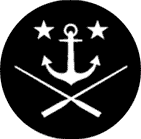History
- from the heart:
"The
Brotherhood of the Coast is a highly disorganized loosely organized
group of people who are bound by love of the sea and a sense of
friendship."
This definition has been presented By Brise-Galets A.K.A. Bernard
Lefevre and is without question the simplest most direct definition
describing our fraternity as we know it today. In my attempt to
define what it means to be a Brother of the Coast I would like to
revise Brise-Galets’ definition as follows: “The Brotherhood of
the Coast is a group of lovers of the sea dedicated to supporting
each other without prejudice , bound by friendship, compassion and
love, governed by the Octalog”.
Even
though it may appear so to the average individual, I do not think that the
Brotherhood of the Coast is disorganized. In my view it is in fact highly
organized. Our Tables are run like ships. We hold regular meetings. We organize
large functions. We travel overseas and many of us sail across oceans -
all quite organized indeed. To be a Brother of the Coast means something
very special. It means that your flag will be recognized the world over
by other Brothers of the Coast and that you will be given harbor wherever
you go in accordance with the Octalog. It means unconditional support, compassion,
and love. Those Brothers who have had the good fortune to meet voyaging
Brothers will attest to the fact that language barriers are quickly broken
by the universal language of the Brotherhood of the Coast.
When we talk about going to a Zafarrancho outside our bay we often talk
about perceived value; what do I get for my money? is often asked. To me
the answer is simple - you get much more than what money can buy - you get
the friendship and love of Brothers from other bays who came to see you
and be with you and share their experiences and their love of the sea. How
can you put a price on that?
In 2006 we will be getting together in Argentina. This is the perfect opportunity
to get together with Brothers from other bays and speak the
language of the Brotherhood of the Coast.
An
Outline History of the U.S.
Brotherhood of the Coast
During November of 1959, John Pflieger established the first United States Table in New York City. His friend, Gordon McCloskey, Honorary Secretary of the Slocum Society, published an article in “The Rudder” in 1958 describing the Chilean Brotherhood and suggesting that Brothers “Tables” be created in the U.S. Chile made McCloskey an Honorary Member of the Chilean Hermandad. John Pflieger was Commodore of the Slocum Society Sailing Club of New York, and in October 1959 he and fourteen members of the Club met in Whyte’s Restaurant in New York and voted to ask Santiago for permission to create a U.S. Table in New York. Dr. Oscar Hammer agreed, and on November 20, 1959 our first meeting was held in the St. Germain Restaurant. McCloskey was made Honorary Captain of the U.S. Brotherhood of the Coast and Co-Founder of the Table of New York. John Pflieger was Co-Founder and Captain.
John Pflieger, as a true romantic, loved the Brotherhood, but he was not a stickler for details, so his letters, invitations, etc. never mentioned the year and his statements made great use of “poetic license”. He reinvented the Brotherhood without regard for the Chilean instructions. His letterheads were more declarations of intentions than factual information, making it difficult to establish historically exact dates in our history of the World Hermandad.
But he is our founding father and he gathered many Brothers in our Table, receiving famous sailors at our Zafarranchos and kept the Table going in great gusto and fun until 1966 when he was lost at sea during a voyage from New York to St. Martin in his twenty-six foot gaff-rigged sloop.
John Pflieger was succeeded by Jean Lacombe, a French single-hander whose first trans-Atlantic voyage was on board an eighteen foot home built sloop. Lacombe was a regular participant in the original OSTAR (single-handed trans-Atlantic) races. His largest boat was a twenty four footer, again home built. He made countless trans-Atlantic and other long voyages. Due to his long absences, the New York Table suffered during his leadership. He eventually took up residence on the Island of Martinique and died in 1996.
During the early 1980’s Jean Lacombe was succeeded by René Fiechter, under whose leadership the New York group prospered and saw the birth of a Table in Texas. In 1986 he organized the first International Zafarrancho and about 300 Brothers from Europe, South America and the U.S.A. attended. This meeting successfully marked the first effort to consolidate the international organization of the Brotherhood and to promote lines of communication and fellowship among all of our far-flung Tables.
At that first International Zafarrancho, it was decided to hold a similar event every four years in different countries. 1990 found us in Belgium, 1994 in Chile, 1998 in Italy, 2002 in Portsmouth, 2006 in Argentina and 2010 we will be in Australia.
After New York, Tables have been created in Charleston, three in Texas, three in Florida, Michigan, Pacific Northwest, Savannah, Chesapeake, Potomac, San Juan, Orange Beach and the Solomon Islands.
Today, three of those Tables have been lost - Charleston, Michigan and Pacific Northwest.
We believe that Rene Fiechter wrote the original text.
"Rasca;" adjusted it to fit the 50th Anniversary celebration in
NYC
**
 ®
®
Brotherhood of the Coast